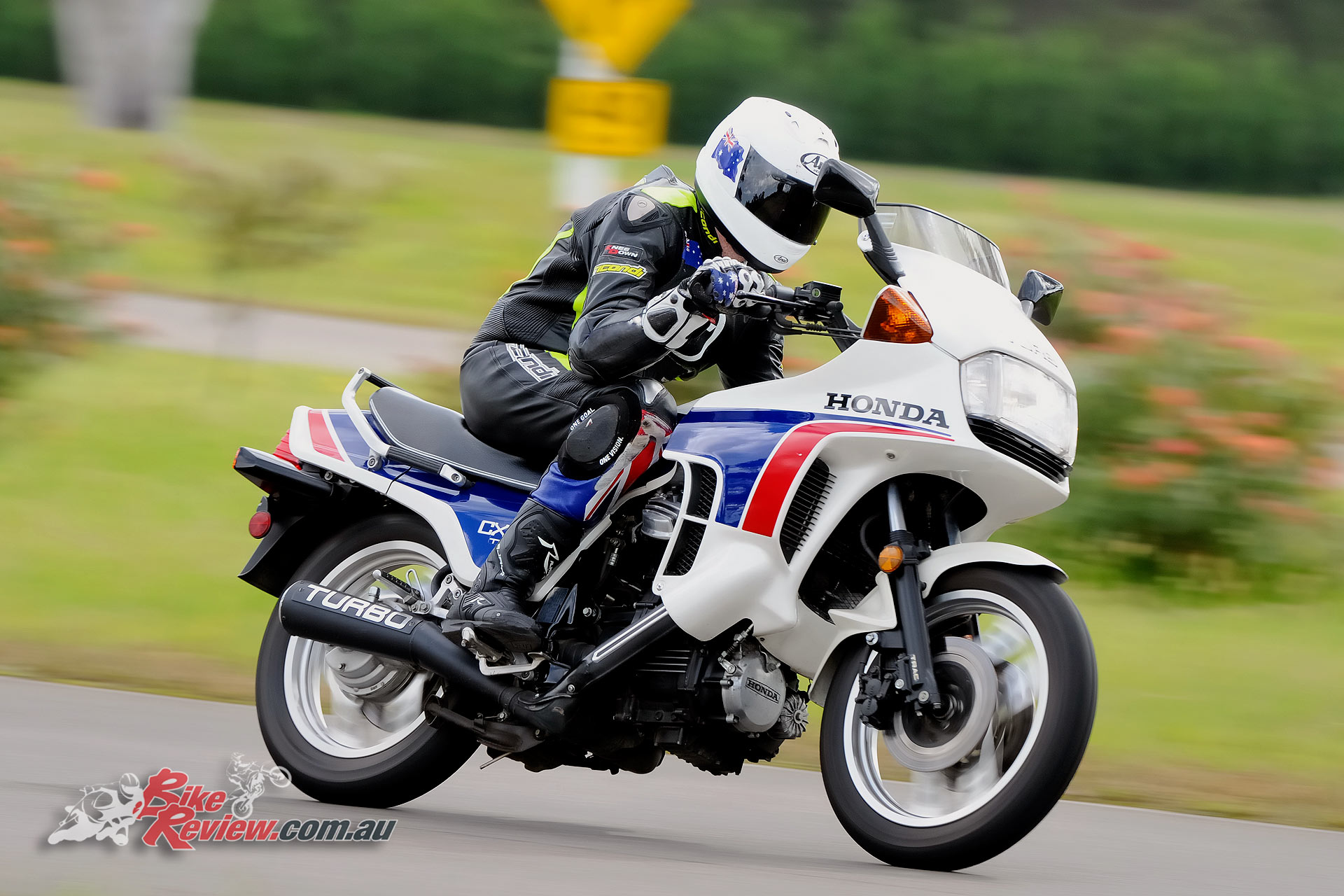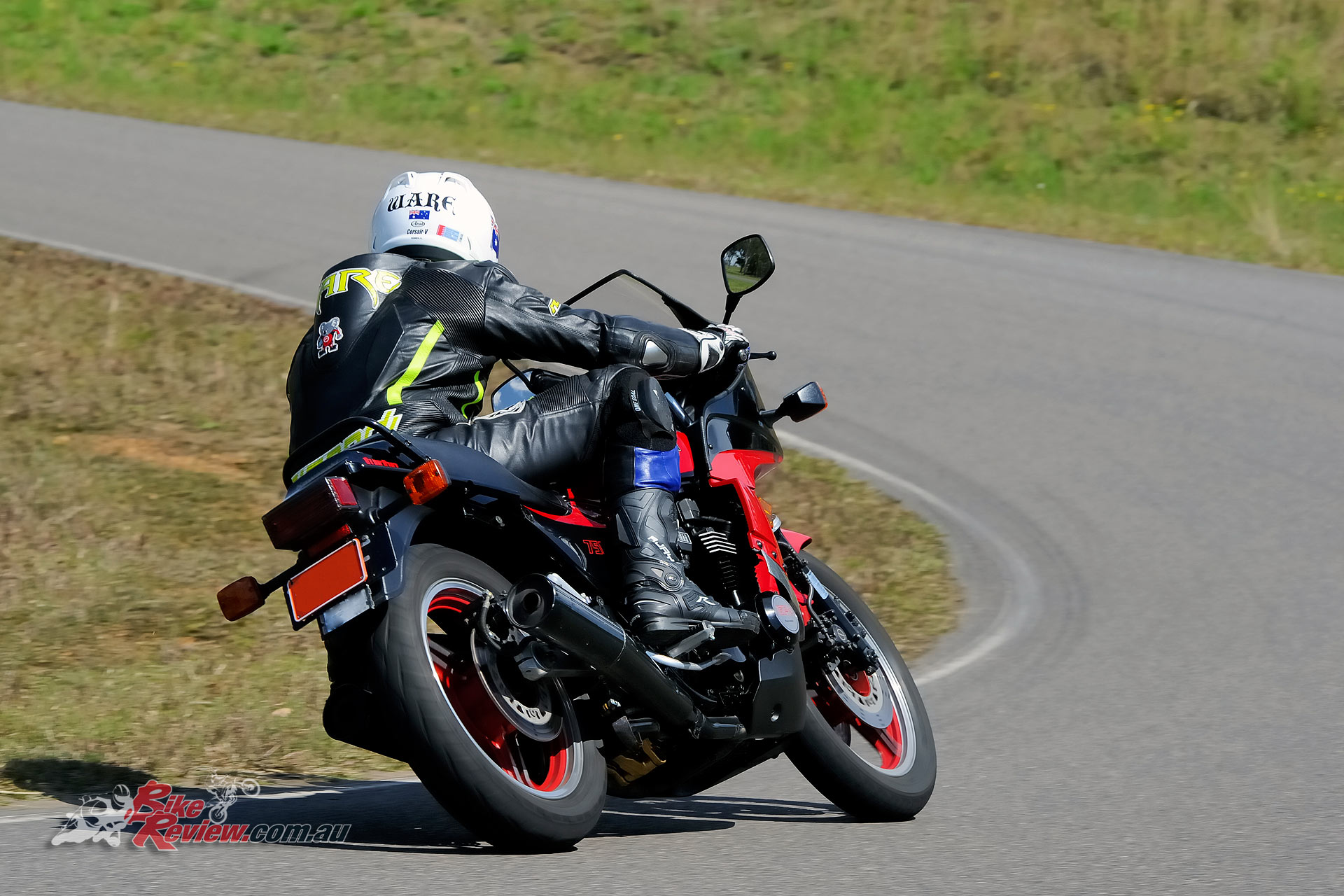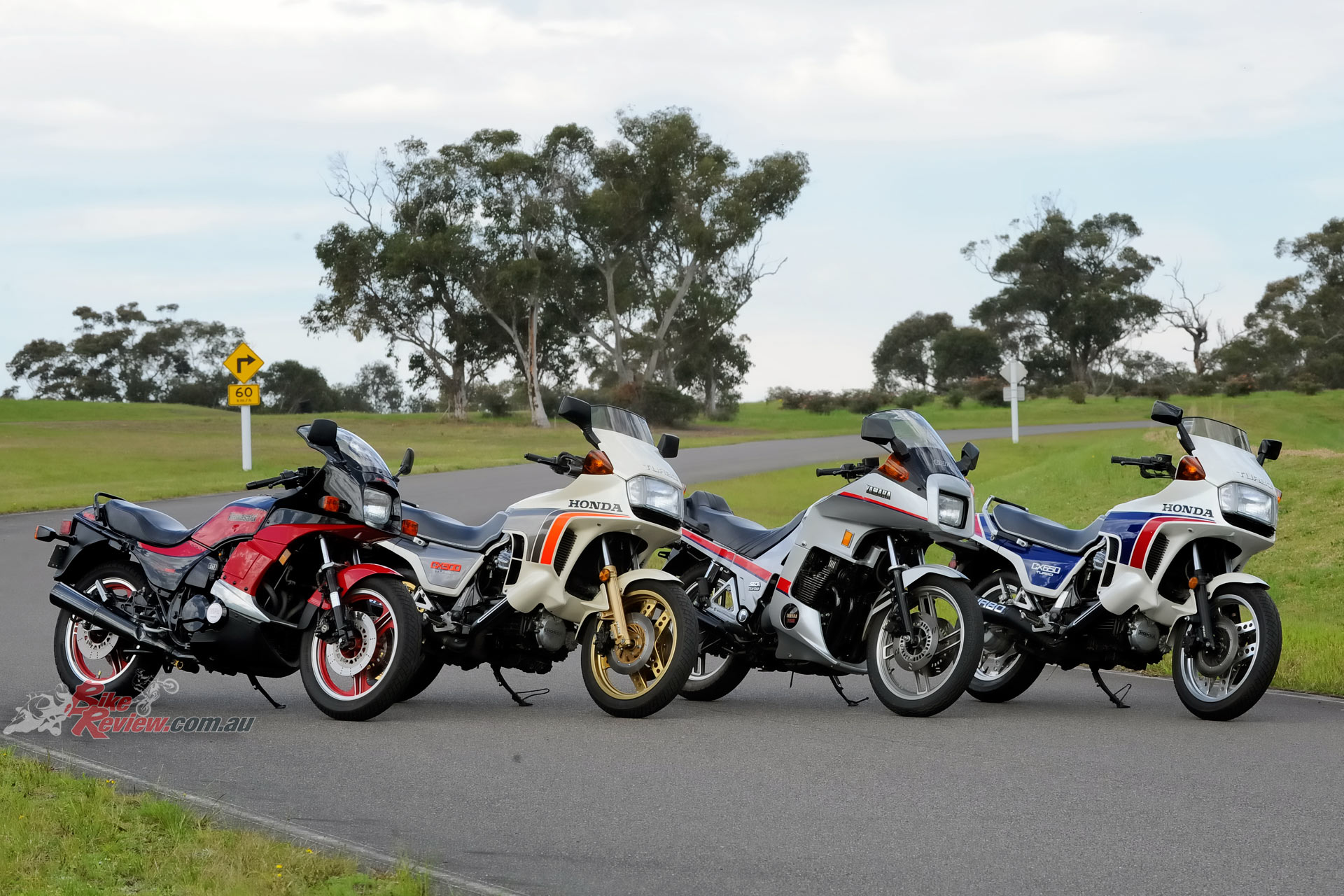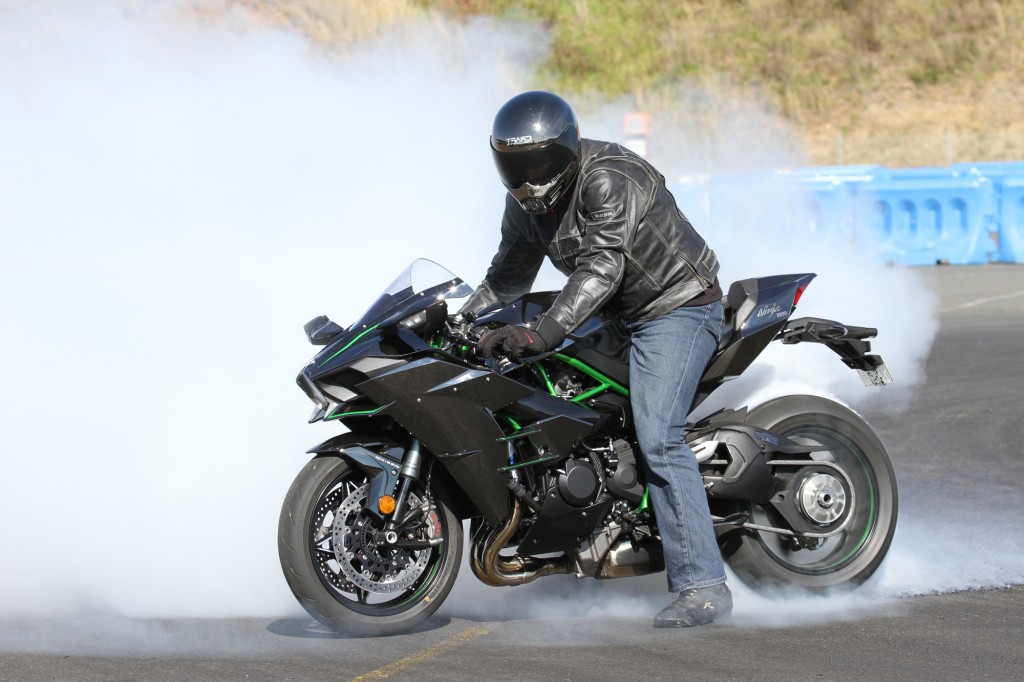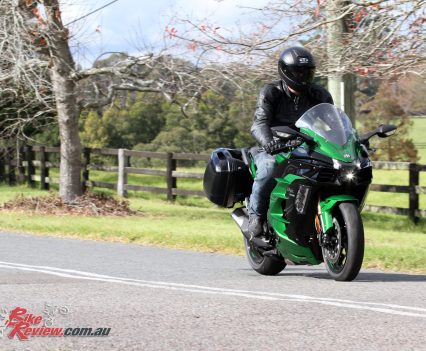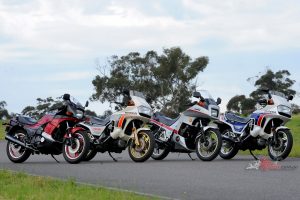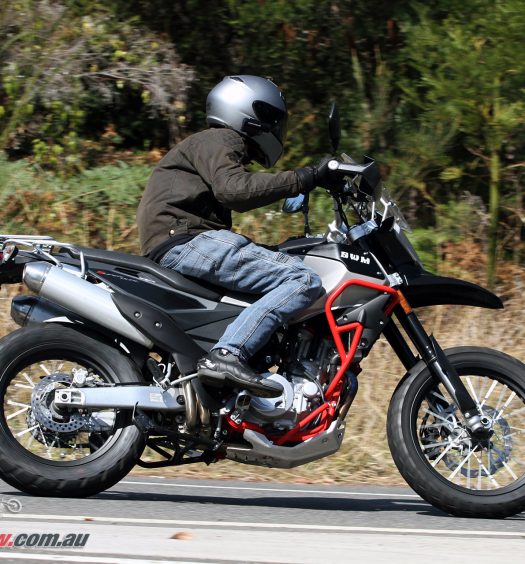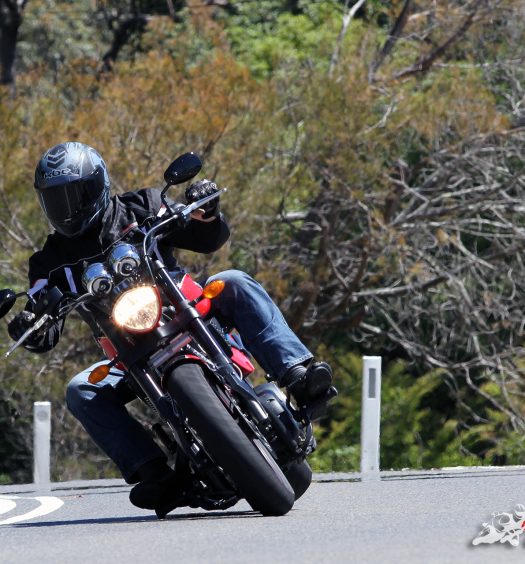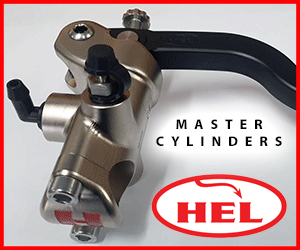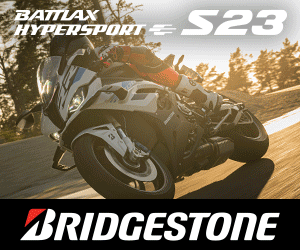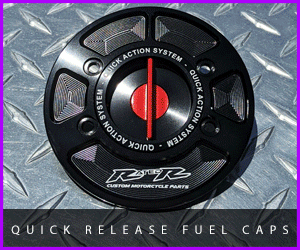Jeff tests the '80s production Turbos, with the Honda CX500 and CX650 Turbos, Yamaha XJ650 Turbo and Kawasaki GPz750 Turbo. Review by Jeff Ware, Photography by Keith Muir
Ah, the 1980s. The decade of Back To The Future, Night Rider, Culture Club, Madonna, wild hair, crazy colours and the digital watch! As a motorcyclist and a huge fan of 1980s bikes the years that interest me the most are the turbocharger years.
When graphics were crazy digital look-a-like fonts and dash displays looked like the screen of your calculator (or the one calculator shared in your office). The Japanese went nuts over forced induction and although they produced some wild and memorable machines the era came and went as fast as you can say ‘fuel pressure regulator’.

The turbo era was short lived but hopefully with the interest in the new Kawasaki H2 and H2R a new forced induction era is on the way. These four (L-R GPz750 Turbo, CX500 Turbo, XJ650 Turbo, CX650 Turbo) are the best of the pick from the 1980s. The missing machine, Suzuki’s XN85, was the lemon of the bunch.
It was only a few years before said manufacturers out-gunned their own futuristic machines with naturally aspirated and less expensive models that were lighter and faster – plus better looking.
Despite all of this, there is no denying the coolness of a factory turbocharged motorcycle, with the words TURBO CHARGED well and truly prominent on the bodywork, “Your bike is turbo charged? Man you are crazy,” was a common comment… talk about fantastic pose factor!
Then there is the style. Japanese engineers going nuts with Manga styled angles and forms, the wildest looking has to be the XJ650 Turbo…
Beneath the futuristic exterior, however, were basic engines – the CX series were pushrod (yikes) twins while the GPz and XJ old air-cooled two-valvers. The XJ even remained carburetted – which, although basic, proved to be the most reliable of the Japanese turbo bikes.
The machine missing from my test is the Suzuki XN85. The Katana styled 673cc 246kg 85hp bike was an epic fail and the most unreliable and poorly selling turbo bike ever. It was slower than its GSX750S naturally aspirated sibling and heavier – plus a lot more expensive.
It also used to break down all the time and the turbochargers would seize, with a replacement cost almost as much as a new bike!
I had one for the test and it was there on the day, but, you guessed it, the immaculate example with only a few thousand miles on the clock broke down before I got to ride it. The XN85, still failing 22-years on…
The Japanese manufacturers went about building their turbo bikes in vastly different ways, not wanting to copy each other. None were truly dedicated models but the Honda CX 500 and 650 could be considered the closest to a dedicated platform, despite being based on the original CX.
Sounds confusing, I know, but a huge amount of testing and development went into the CX500 and 650. The engines were heavily modified and the 500 was the first ever bike with a dedicated computer controlled engine management system and it worked well.
The CX was fuel injected, as mentioned also a first, and had multiple sensors measuring boost, air flow, air temperature, engine temperature, rpm, throttle position and crank position, camshaft position and load.
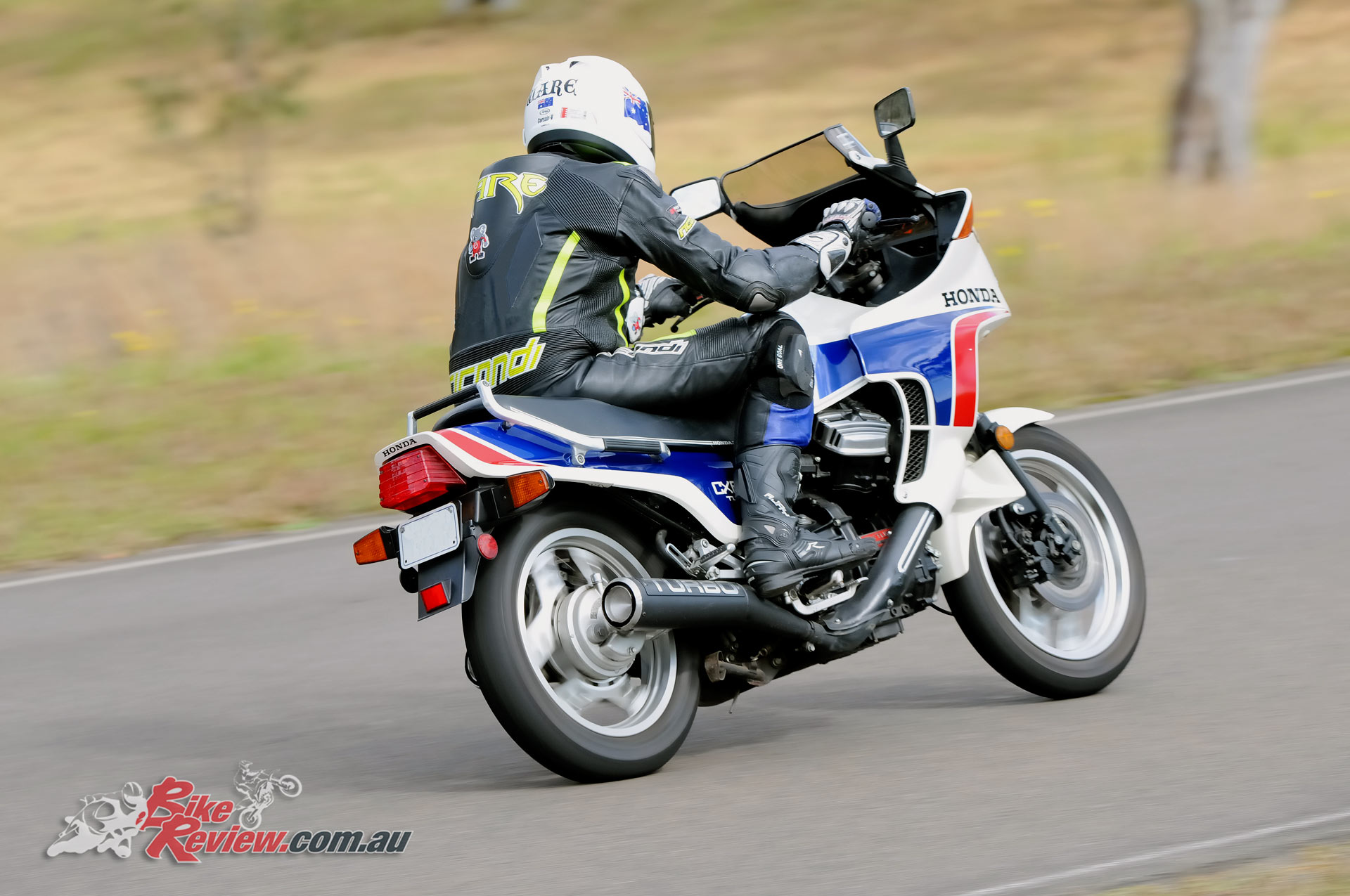
The tall screen and wide ‘bars, along with a plush seat, make the CX650 the ultimate hooning tourer. It looks fat and old and slow but hammers. It was on the back wheel off some turns!
The ignition and fuelling were both computer controlled and there were default settings in place that could get the owner to a Honda dealership or home in a limp mode in just about any situation. This is, of course, an amazing achievement for the era and must have cost Honda serious bucks.
As for the turbocharging system on the CX, it was less perfect than the GPz but much better than the XN or FJ. A basic principal in turbocharging is that intake air temperature needs to be kept as low as possible. This was a pre intercooling era, so alternatives needed to be found.
Honda decided to front mount the turbo between the V of the 80º cylinders, to take advantage of cool air. Of course, what the trade off was is extreme heat generated by the turbo and thus a ot of hot air around the fuel rail and tank. Hot fuel can have as bad an effect on combustion efficiency as hot air does in a turbo system.
Front mounting the turbo also reduces lag a little on the CX but header length dictates that it is not as effective as the GPz set-up.
The CX turbo draws through an oiled foam filter, not ideal and easily swallowed once deterioration sets in. From there, there is a long intake pipe to the turbo and on the compressed side another long turbopipe leading to the plenumn chamber, which is a plastic sealed airbox in this case.
The compressed air then needs to pass through yet another set of plumbing to the intake manifold and even through a set of reeds. No wonder there is lag! The set-up is not ideal but it’s not bad for the era and with the 650 there is much improvement – thanks to the extra capacity and compression ratio.
The Kawasaki is the only other front mount turbo set-up and was done very well, for a different reason and a more sensible one – to reduce lag. The shorter the turbo headers, the quicker the exhaust flow will reach the compressor wheel and spool up the turbo.
The low and forward mounting of the GPz turbo also allows the turbo to get cool airflow while on the move and the positioning of it means the cool air will carry the heat generated by the IHI turbo down and under the crankcases, past the back tyre and gone – away from the engine. A smart move by Kawasaki and to this day the spot that most turbochargers are mounted on custom motorcycles.
The GPz turbo is slightly larger than the CX and XJ units, so despite the shorter header length there is some lag simply due to the ultra low compression ration of the bike, the slow throttle response of the basic EFI and the diameter of the impellor in the turbo. Once it is spinning, however, there is no stopping the mighty GPz!
The turbopiping was also fantastic on the GPz. Very short – opposite to the others. From the turbo to the plenum chamber was a very short distance around the cylinder block. The wastegate was mounted to the turbo and vented via plumb back to the airbox and the fuel rail was very close to the cylinder-head, with very short inlet manifold. All up it was a system that for the era was pretty much perfect. Not much could be done at that time to improve it.
The XN and XJ both have rear mounted turbochargers. Why? You have to wonder. I really don’t get it!
The tiny turbo was mounted basically where you would find your rear shock linkage on a modern bike. Behind the engine sump, around three inches in front of the back tyre. It was like an automatic full time tyre warmer!
This spot was a fail and a half. The turbocharger got little to no cool air, in fact, it got hot air from the already overhot engine. It was also an eternity before exhaust gasses reached the impellor to spool up the turbo as it was at the end of the collector pipe!
So imagine, you open the throttle anticipating acceleration and have to wait all of that time before the turbo comes into effect…
The turbopiping from the compressed side was routed up behind the crankcases to the plenum chamber and then mixed and distributed by four Mikuni CV carburettors, which had pressurised float bowls to prevent the forced air from basically blowing all of the fuel out of them.
On the intake side of the turbo was another restriction – a large airbox. It was a lose lose situation. Oddly, one side of the exhaust system on the XJ is fake and simply vents from the wastegate. It is actually a four-into-one not a four-into-two!
As for the XN, Suzuki applied the same principals as Yamaha by adopting the ‘blow through’ system, only Suzuki did it much, much worse.
They must have been handing out free acid at the factory when Suzuki engineers agreed to mount the XN85 turbo – wait for it – behind the cylinders, on top of the gearbox/upper crankcase. The was insane. It got zero airflow aside from super heated air from the cylinders!
The exhaust headers had to wrap around the entire engine, come up behind it between the swingarm pivot point and the crankcases, just to spool the turbo up! It was mental!
From there the now super heated intake air was compressed and fed to a plenum chamber via a giant loop around the left side of the bike. At least the Suzuki had EFI though. But in turbo fail ratings it is a 10/10 for failure.
THE RIDES: CX500T, CX650T, GPz750T, XJ650T
A local bike collector and I got talking one day and soon realised he had all Japanese turbo bikes in his collection. All were very original – down to OEM rubber – and most only had a few thousand miles on them. The bikes are here in Australia but originally hailed from the USA so are all US specification with US era tyres, lights and exhausts.
The test took place on a private 3.9-mile 22-corner tarmac proving ground I use for a lot of my testing, as the bikes are not street registered here in Australia.
Everything on the bikes was stock right down to the grips and levers. I really felt like I had stepped back in time. It was a dream come true for me, as I was a wide-eyed kid when these machines were turning heads and I remember how bad I wanted to ride one back then. Riding a turbo bike was equal in credibility to flying a fighter jet as far as I was concerned…
So the question is, how do these old beasts perform? Having recently tested the Kawasaki H2 I had no power expectations, but I was more than keen to feel how the bikes performed compared to naturally aspirated bikes of the same era.
The same day as this test I rode a lot of era bikes such as the GSX-R750F, Z9, Z1R, Honda 4, Kwaka 750 triple, RZ350, a few Ducatis and some others – so I had a good comparison base and at the end of the day.

The 500 was the first mass produced turbo motorcycle in the world. There had been limited run turbo bikes in the past but not a mass-produced model. It was also the first motorcycle to feature EFI when it was released in 1982.
Honda CX500 Turbo
The first turbo bike I rode was the best looking one, the CX500. The 500 was the first mass produced turbo motorcycle in the world. There had been limited run turbo bikes in the past but not a mass-produced model.
It was also the first motorcycle to feature EFI when it was released in 1982. Although the pushrod V-twin was an old design and had remained unchanged sine 1977, it did have some benefits. It was liquid-cooled, had strong cases, produced strong torque by geometry and could help keep costs to a minimum.
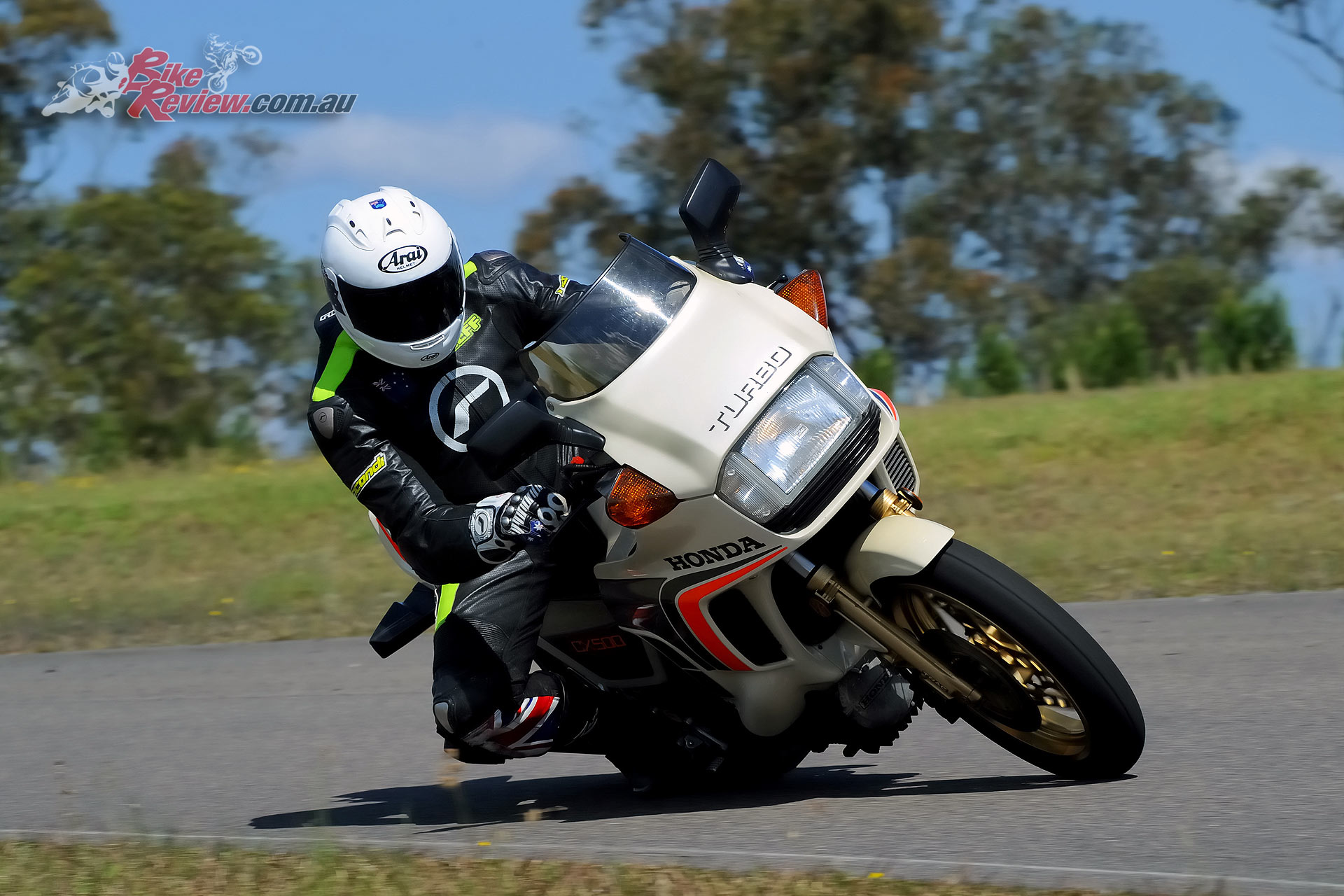
The CX500 truly is a great handling bike. The engine is also a cracker, although a little peaky. The big surprise to me was how good the EFI was. The bike had a nicer throttle than most modern machines.
Honda beefed up the internals including the crankshaft, reduced compression and fitted complex for the day EFI and a little 51mm turbocharger that was front mounted nice and close to the exhaust headers, with a single dump pipe looking very cool on the right-hand side, exiting via a muffler with huge TURBO badge. The turbo location reduced lag and was a good move.
The CX500 featured TRAC anti dive, air-assisted adjustable rear Pro Link suspension and twin front rotors with two-piston floating calipers. As a sport-touring bike, it also had a big comfy seat and a tall screen with upright riding position.
I fired up the CX and it doesn’t miss a beat, idling away with a slight left and right chug as the big crank spins clockwise with the low comp pistons swinging off the end.
I hop on and familiarise myself with the 500. It is really comfy. A wide, soft seat with a tall screen and high ‘bars. The kind of bike you could ride all day long. It also has that Honda quality, with some nice touches around the dash area and good quality paint and graphics. It looks good, 23-years on…
Clutch in, select first (no clunk) and off I go. I ease around for the first lap due to the age of the tyres (this one had reasonably new Bridgstones as opposed to some bikes in the test that had original rubber). So once I get a feel for the brakes and tyres I actually start to push and I am surprised. This thing really goes pretty hard!
The CX500 Turbo is peakier than I anticipated and once the turbo spools up (there is some lag) the power hits quite hard for a short period of time before tailing off painfully, when the bike gets asthmatic…
Keep it spinning in boost, however, via the smooth and wide ratio five-speed gearbox, and you are rewarded with a torquey, punchy bike that offers the pull of a much larger capacity motorcycle.
The old school power delivery is fun – nothing then ‘boom’ a quick rush that sees the skinny forks extend to full length and it really does make me grin as I lap on the old beast.
The handling is the big surprise. Wow. For a bike that looks like a Moto-Guzzi on acid I can’t believe how well it steers and tracks through a turn. Front-end confidence is high and I’m shocked. It seems Honda had their geometry numbers a step ahead of the other brands even back in 1982…
The brakes are also fantastic – another surprise.
At the end of my 30-minute test I’m absolutely blown away. How can a bike that looks like this feel completely different?

The CX650 replaced the 500 just 12-months after the 500 was released. Fundamentally the same chassis, the 650 has uprated brakes and revised suspension as well as a broader spread of power. The ultimate sports tourer, aimed squarely at the American market and only sold in the USA.
Honda CX650 Turbo
I wander down to the next bike and fire it up – the mighty 1983 CX650 Turbo, the bike that replaced the 500 after just 12-months.
The 650 is a bored and stroked version of the 500 with more compression (7.8:1 versus the 500s 7.2:1), a fatter front tyre, stiffer rear shock and a peak boost of 19psi from the 51mm turbo.
The chassis and bodywork is basically unchanged from the 500 aside from paint and graphics but the example we have here is much more modern looking than the 500 in my opinion, thanks to the white and blue color scheme.

I was speechless after I rode this bike. It is so ugly but it handles well and corners with grace. It also surges off turns with ferocity. Amazing.
I roll out of pit lane and onto the main straight, open the big 650 up and I’m instantly grinning! The lag of the 500 is gone and the 650 reacts to throttle input much faster thanks to the increase in compression and EFI improvements.
There is a strong, grin inducing, surge of power and with 100hp at the crankshaft this bike really is a quick thing. In fact, the front wheel comes up in first gear with a bit of a nudge and gets light on the gas in the first three gears. The gearbox ratios are revised on the 650 also and the package works well.

The 650 front-end is fantastic but the bike lacks ground clearance. More than makes up for this with acceleration though.
The biggest surprise for me is how smooth the fuelling is. Modern bikes are less progressive on the throttle. Like the 500, the 650 handles really well and the brakes are impressive.
This is a machine that has been so well tested and developed – specifically for the North American market (the only place it went on sale – in part to help avoid the over 700cc tariff on Japanese imports that was successfully imposed after lobbying from Harley-Davidson).
The CX650 is a blast. It is fast and it handles well – plus so comfortable you could tour the States on it. What an underrated bike that just slipped through the radar. A real jewel of a motorcycle.
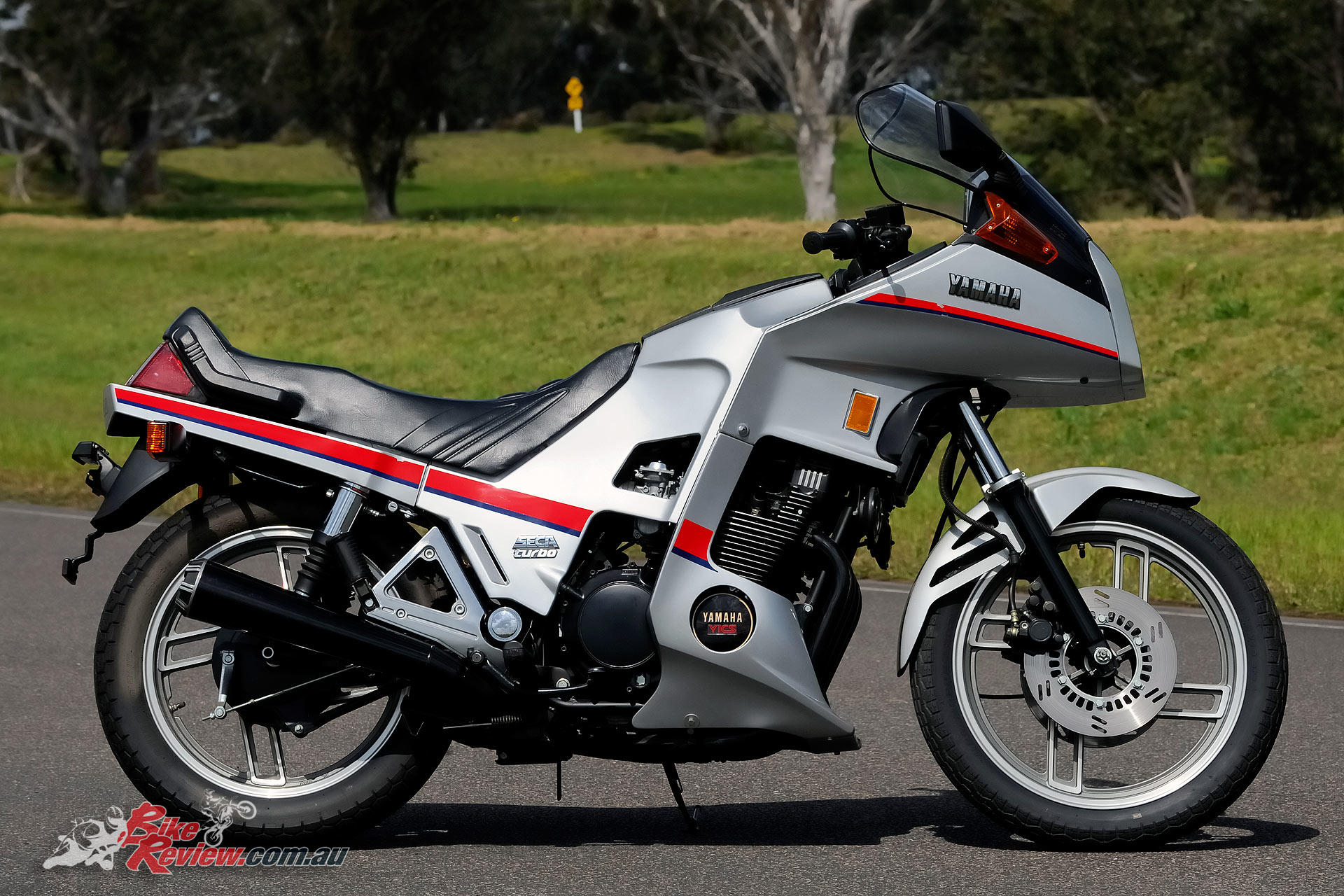
The Yamaha XJ650 was a bitsa made from a Seca chassis with a small turbo and CV carb’s. However, this allowed Yamaha to keep costs down and also made the XJ the most reliable of all Japanese turbo bikes of the era.
Yamaha XJ650 Turbo
The ugly duckling came next – the Yamaha XJ650. Where the Hondas are high tech and highly equipped, the XJ is basic. Yamaha attempted to keep the price tag of a turbo motorcycle down.
However, the result is really a bike made from leftovers. A Seca chassis (ouch), oil and air cooling (yikes) pressurised CV carburettors that actually proved more reliable than EFI and lastly, a turbo with a light switch power deliver that caused the already bad chassis to get worse!
The Yamaha styling is also, err, well you can decide for yourself…

Off turns the XJ makes you laugh out loud. It’s all nothing, nothing, nothing then ‘bam’ frame flex and wiggling ‘bars. A real hoot but not practical.
I hopped on the Yamaha and unlike the Hondas, the Yamaha does not feel well developed, tested or though about. The seat is thin, the ‘pegs low, the ‘bars awkward and the bike feels confused.
I start up the inline four and it idles away smoothly enough and is louder than the others despite one fake muffler. I head off for my 30-minutes of fun and within a few corners I know the bike is a fail.
It handles like junk; the brakes are weak and the ride position awkward. On paper the chassis is similar specification to the GPz750 but in reality is is quite different. The rear brake is a drum and the front brakes equally as bad as the Kwaka.
With the little turbo mounted miles away from the cylinder-head the XJ suffers lag and being carburetted means that although the throttle action and application is smooth, the actual fuelling adds to the peaky nature of the bike. Oddly, the XJ is shaft drive, which makes no sense as it is supposed to be a sportsbike – and the shaft drive ads to the odd handling of the bike.
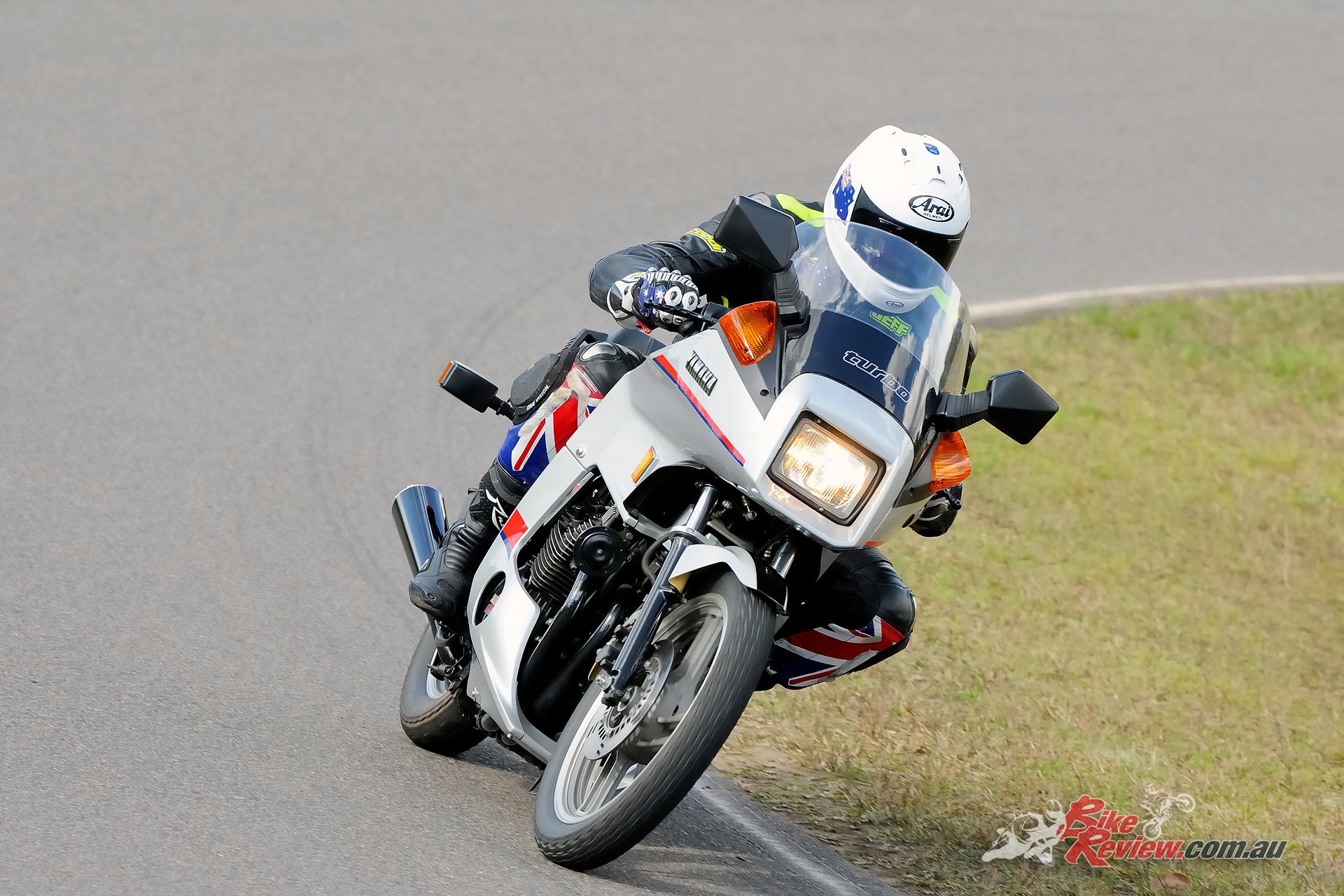
he XJ650 has weak brakes and an awkward riding position. Getting the bike into a turn is a challenge. I get the feeling Yamaha put more emphasis on Night Rider / Mad Max styling rather than epic handling!
However, before you think I hate the XJ, let me tell you, there is something stupidly fun about a badly designed turbo system that is all lag then suddenly all power. It is a hoot hanging on and letting the poor old Seca chassis twist and weave around – in fact; the XJ650 Turbo is, if anything, one of the most grin-inducing motorcycles from the early 1980s – only for all the wrong reasons.
The bike got slower as my test went on and the engine and intake temperatures rose. By the end I think I was literally cooking on the bike!
Yamaha – what were you thinking?
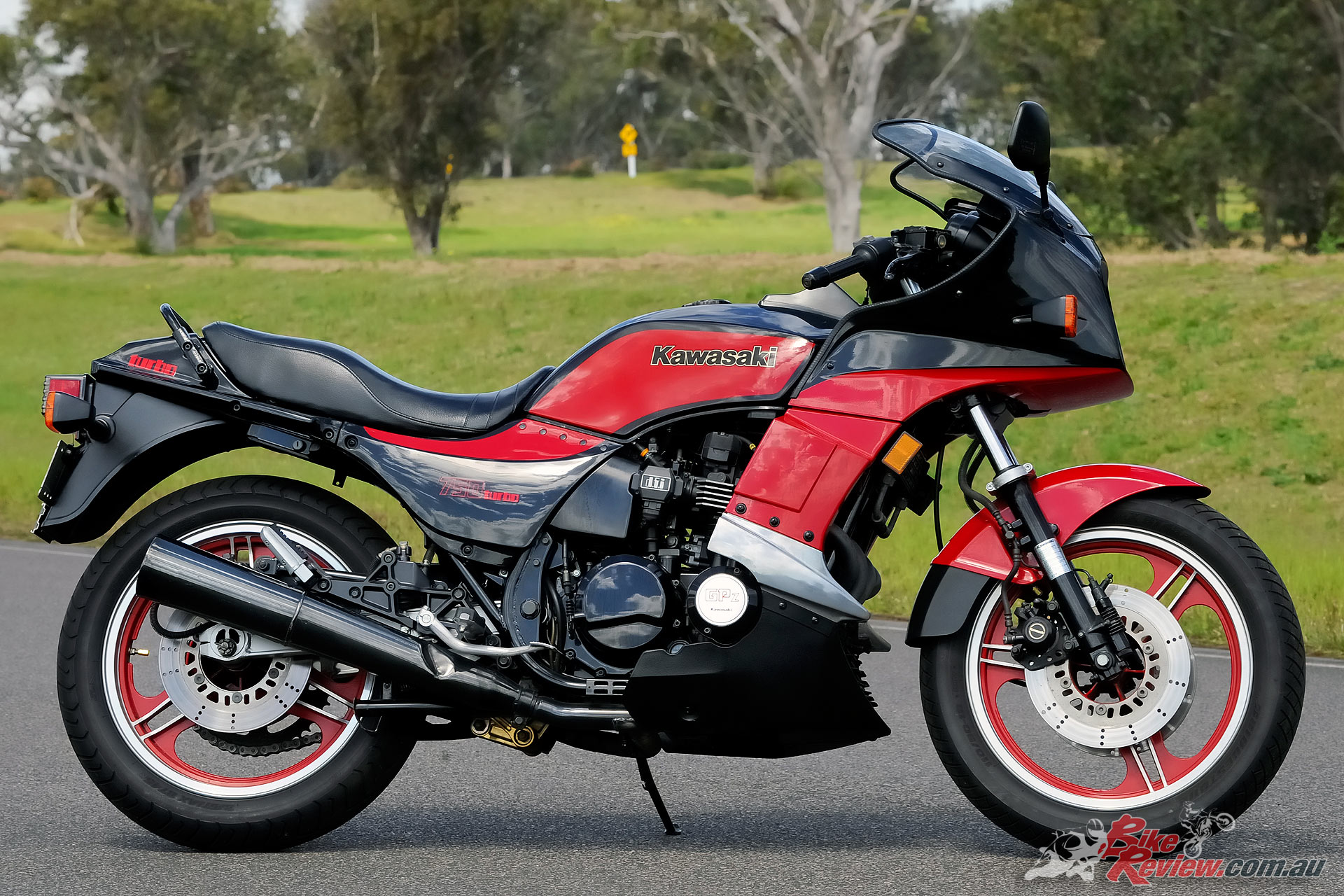
The turbo era was short lived but hopefully with the interest in the new Kawasaki H2 and H2R a new forced induction era is on the way. These four (L-R GPz750 Turbo, CX500 Turbo, XJ650 Turbo, CX650 Turbo) are the best of the pick from the 1980s. The missing machine, Suzuki’s XN85, was the lemon of the bunch.
Kawasaki GPz750 Turbo
I headed into the test open minded but there was without doubt a favourite and it is no secret that the most successful turbo charged motorcycle to come out of the 1980s turbo boom is the famous GPz750 Turbo, Kawasaki 750 Turbo or ZX750E– depending on where it is!
Released in 1983 but developed from 1981 onwards, the 750 Turbo smashed all but the CX650 out of the water with top speed and blew all of them away over the 1/4-mile with an incredible 10.71 recorded at the World Press Test by Jay Gleason.

The GPz is big and long and quite heavy. It’s chassis is sporty but not on par with the Hondas. The top end power makes up for it.
That is a fast time in 2015 let alone back then and after riding the 750 Turbo I truly believe that it is capable of sub-11s. It’s an amazing bike! With a whopping 112hp@8500rpm and big torque at 73.1ft-lbs@6500rpm, the 750 hauls and is great fun to ride.
The standard 750 was a great sportsbike and the Turbo retains that great handling and the sleek looks, which are improved thanks to the Turbo spoiler.
The engine got a deeper sump and extra oil scavenge pump as well as dedicated turbo headers and revised suspension. Geometry was raked out from 26º to 28º to make clearance for the turbo.
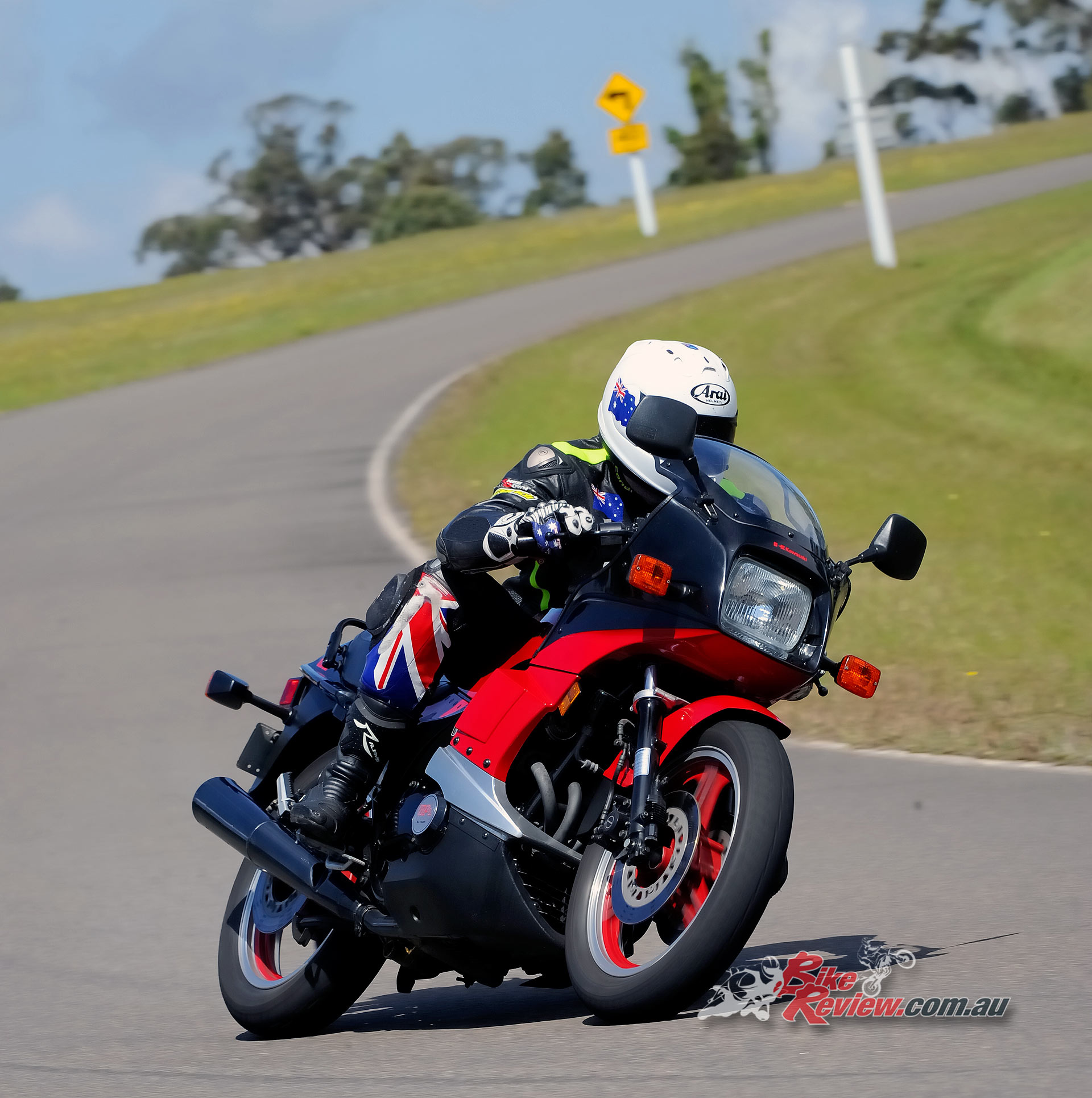
The GPz lacks support on the front and the brakes are poor, even for the era, however I still felt confident on the bike and could carry decent pace into a turn.
I hopped on the 750 and immediately felt the sporting heritage. It is low. It is long (a trend of the era) and sleek, with full fairing, clip-on ‘bars, rear set footpegs and a long reach to the ‘bars giving a tucked in position. The styling, including the paint, sets the 750 Turbo above the others in every sense. This bike means business.
I head out on the 750 and crack up laughing in my helmet by turn one at the end of the long uphill front chute. This thing hammers! It really is quick for a 1983 model motorcycle. After riding almost every naturally aspirated and turbo charged bike from the era, then jumping on this at the end of the day, it is not dissimilar to how I felt riding the new Kawasaki H2 recently. I’m blown away.
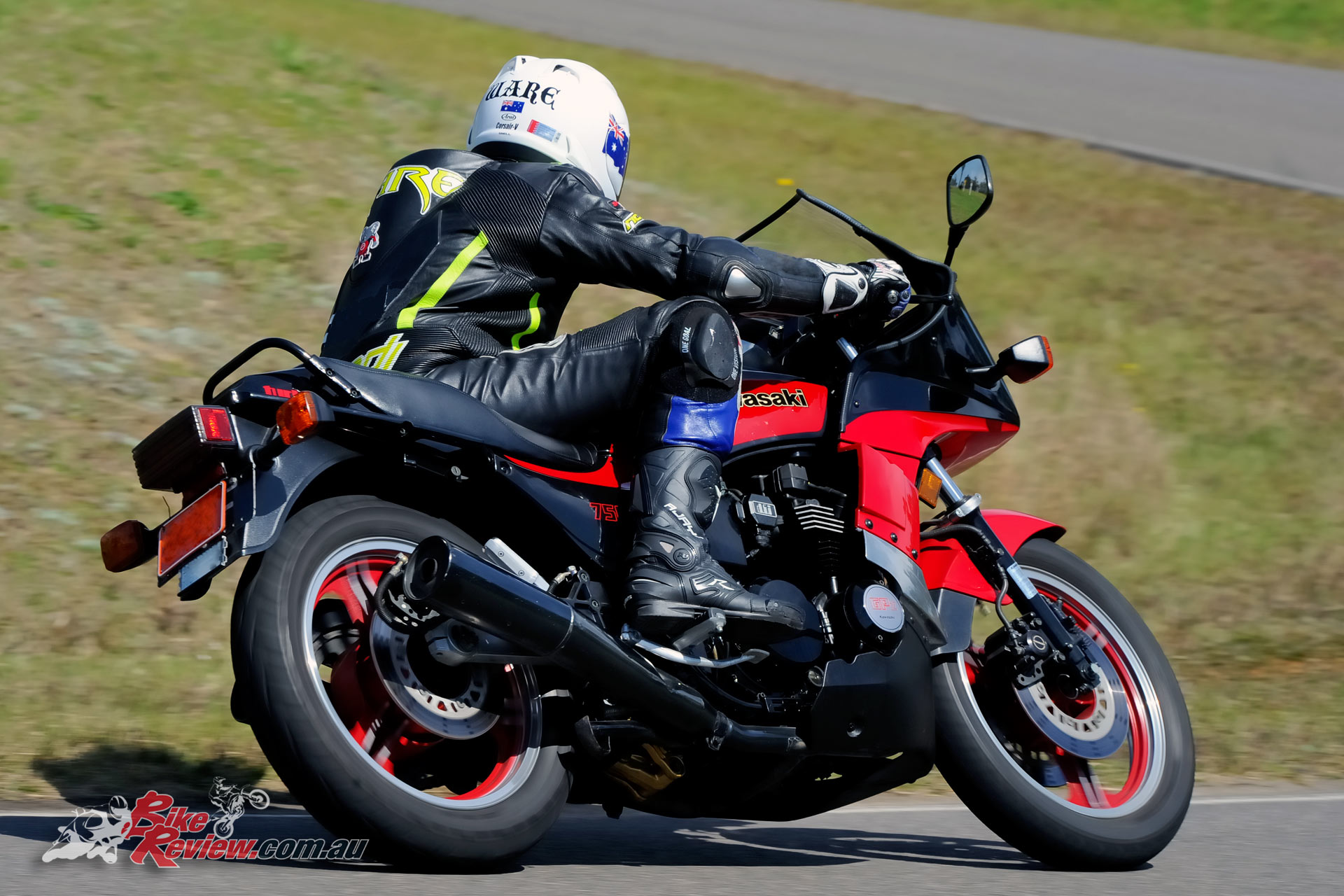
The long reach to the ‘bars, high ‘pegs and tall screen give the GPz that lay down riding stance – ready for land speed riding!
The 750 is laggy despite the front mounted turbo – but a lot of the lag is due to the ultra low compression ratio.
Once the turbo starts to spool up, however, and boost comes on strong, the 750 Turbo takes off like crazy and revs hard all the way to redline – it just keeps on pulling gear after gear. I even got some wheelspin off some turns.
And just when I was buzzing with adrenaline from the mighty acceleration (for the era), the thrills increase as I try to stop the thing!
The 750 Turbo brakes are grossly inadequate as is the front for support and rear shock control. It doesn’t handle nearly as well as the CX650, however, it absolutely hammers so that more than makes up for it!
I think the Kawasaki 750 Turbo will and should go down in history as one of the coolest bikes ever made – and Kawasaki is doing it again with the mighty and manic supercharged H2, Z H2 and SX SE. Let’s all hope we are about to experience another forced induction era from the Japanese – and that we can enjoy it without insurance or road tax penalties killing them off again…
Until then – may the boost be with you!
TOP SPEEDS (OFFICIAL FACTORY CLAIMS)
GPz – 148mph (238km/h)
CX5 – 128mph (206km/h)
CX6 – 140.4mph (226km/h)
XJ – 125mph (201km/h)
1/4-MILE TIMES (OFFICIAL FACTORY CLAIMS)
GPz – 11.2@125mph
CX5 – 12.3@106mph
CX6 – 11.9@112mph
XJ – 12.68@106mph

The turbo era was short lived but hopefully with the interest in the new Kawasaki H2 and H2R a new forced induction era is on the way. These four (L-R GPz750 Turbo, CX500 Turbo, XJ650 Turbo, CX650 Turbo) are the best of the pick from the 1980s. The missing machine, Suzuki’s XN85, was the lemon of the bunch.
SPECIFICATIONS: Kawasaki GPz750 Turbo
Engine: Turbocharged air-cooled inline four-cylinder DOHC, eight-valve, four-stroke, 738cc, 7.8:1 compression ratio, 66 x 54mm bore x stroke, five-speed gearbox, wet multi-plate clutch, electronic fuel injection
Chassis: Steel single spine frame, Kayaba anti-dive conventional forks, Uni-Trac rear suspension with alloy swingarm, dual front rotors with single-piston calipers (f) and single rear rotor, 110/90-18in (f) and 130/90-18in (r) tyres, 1490mm wheelbase, 780mm seat height, 223kg dry weight, 241kg wet weight, 18L fuel capacity.
Performance: 112hp@8500rpm, 73.1lb-ft@6500rpm
SPECIFICATIONS Honda CX500 Turbo
Engine: Turbocharged liquid-cooled 80º east-west V-twin pu
The Verdict | Classic Turbos: CX500T v CX650T v GPz750T v XJ650T
Wild!
Ah, the 1980s. The decade of Back To The Future, Night Rider, Culture Club, Madonna, wild hair, crazy colours and the digital watch! As a motorcyclist and a huge fan of 1980s bikes the years that interest me the most are the turbocharger years.




